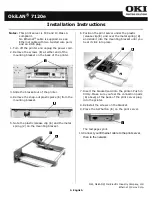
Chapter 1: Overview
MAXCS ACC 6.7 Administration Manual 5
Distinctive Call Waiting Tone
- allows three different
call waiting tone
cadences to
distinguish between internal, external, and operator calls.
Distinctive Ringing
- allows three different
ringing
cadences to distinguish between
internal, external, and operator calls.
Do Not Disturb
- blocks all calls coming into a specific extension and sends them to
preprogrammed destinations such as voice mail or the operator.
Extension Activity Display
and
Greeting
- allows users to select from a set of pre-
defined or customized activity codes that can be played or displayed when the user is
absent. A greeting associated with the activity can be recorded and played to the caller.
The activity is displayed if the caller is an MaxCommunicator, MaxAgent, or IP phone
user.
Extension Based Feature Profile
- the system administrator is able to create an
extension feature profile that includes enabling and disabling of extension features.
FSK-based Message Waiting
- allows message waiting that is based on frequency-
shift keying (FSK), a modulation technique for data transmission.
Hands Free (dial tone mute) Mode
- by pressing
#82,
allows a user to leave handset
off-hook or use a headset without having to hear the dial tone.
Hands Free (Intercom) Mode
- by pressing
#81
while on their speaker phone, users
can receive internal calls without having to pick up the handset to answer.
Holiday Routing
- routes inbound DNIS and trunk calls on designated holidays to
specified destinations. You can create separate routes for business and non-business
hours on half-day holidays. Multiple Holiday Profiles can be configured in a system. Also,
multiple Holiday Profiles can be assigned to DNIS Routing, Caller ID and Trunk In Call
Routing entries.
Hop Off Calls over VoIP or T1/PRI Tie Trunks
- multiple systems at the same or
remote locations can be linked through VoIP or T1/PRI networks. Also, this feature
provides toll savings on long distance calls by allowing users to dial a remote system via
VoIP or T1/PRI trunk and then the destination phone number through PSTN.
Hunt Group
- a group of extensions can be set up to perform call coverage, so that if
the first extension is busy, the next extension is hunted until a free extension is found.
If all extensions are busy, the incoming call will be queued and listen to background
music.
Individual and System Call Pick Up
- allows users to answer a ringing telephone from
another station.
Intercom Call
—by pressing #93 on an analog phone, users can make an intercom call
to an AltiTouch 510 or an AltiGen IP phone. If the phone is in idle state, the phone
speaker will be turned on, and the voice path is connected. If the target phone is busy,
the caller will hear a busy signal. This feature can be enabled or disabled per extension
by the administrator.
Line Park—
allows for a set of 99 lines to be used as a park pool, where trunk incoming
calls can be parked automatically, (by routing/call handling treatment in
MaxAdministrator). Park Lines are organized into groups, with up to 99 groups
supported. Parked Lines can be assigned to an IP phone programmable key for call
pickup. Line Park group has busy queuing and time out transfer options.
Live Call Handling—
allows a caller to hear a ringback tone when the extension user is
in voice mail, paging, transfer, or conference state. Designed primarily for the operator,
the call is shown as “ringing” in AltiConsole.
Meet-Me Conference
—MeetMe conference scheduling, monitoring and control.
Summary of Contents for ACC 6.7
Page 16: ...2 MAXCS ACC 6 7 Administration Manual ...
Page 44: ...Chapter 2 System Requirements and Installation 30 MAXCS ACC 6 7 Administration Manual ...
Page 56: ...Chapter 3 Getting Around MaxAdministrator 42 MAXCS ACC 6 7 Administration Manual ...
Page 98: ...Chapter 6 Voice Mail Configuration 84 MAXCS ACC 6 7 Administration Manual ...
Page 108: ...Chapter 7 Auto Attendant Configuration 94 MAXCS ACC 6 7 Administration Manual ...
Page 124: ...Chapter 9 Call Recording Configuration 110 MAXCS ACC 6 7 Administration Manual ...
Page 128: ...Chapter 10 Application Extension Configuration 114 MAXCS ACC 6 7 Administration Manual ...
Page 180: ...Chapter 12 Trunk Configuration 166 MAXCS ACC 6 7 Administration Manual ...
Page 186: ...Chapter 13 In Call Routing Configuration 172 MAXCS ACC 6 7 Administration Manual ...
Page 234: ...Chapter 16 Setting Up IP Extensions 220 MAXCS ACC 6 7 Administration Manual ...
Page 246: ...Chapter 17 AltiGen IP Phone Configuration 232 MAXCS ACC 6 7 Administration Manual ...
Page 256: ...Chapter 18 Mobile Extension Configuration 242 MAXCS ACC 6 7 Administration Manual ...
Page 270: ...Chapter 19 Hunt Group Configuration 256 MAXCS ACC 6 7 Administration Manual ...
Page 274: ...Chapter 20 Paging Group Configuration 260 MAXCS ACC 6 7 Administration Manual ...
Page 370: ...Chapter 26 Redundancy Configuration 356 MAXCS ACC 6 7 Administration Manual ...
Page 404: ...Chapter 29 TAPI Integration 390 MAXCS ACC 6 7 Administration Manual ...
Page 426: ...Chapter 30 Tools and Applications 412 MAXCS ACC 6 7 Administration Manual ...
Page 448: ...434 MAXCS ACC 6 7 Administration Manual ...
















































